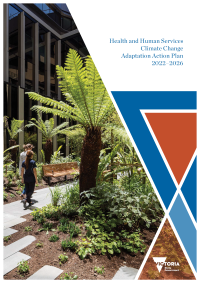The Health and Human Services Climate Change Adaptation Action Plan is one of 7 plans prepared by the Victorian Government for 7 statewide systems. The plans will help ensure Victoria’s climate resilience, now and into the future.
The challenge
The World Health Organization describes climate change as the greatest threat to global health this century.
Climate change is already affecting health and human services in Victoria, which include public health and wellbeing services and assets, social housing infrastructure, and support for vulnerable community members. The system is central to life across our state – more Victorian residents work in healthcare and social services than any other industry. The Victorian Government manages more than $23 billion in health assets and more than $26 billion in public housing assets.
Victoria’s warmer temperatures are increasing the vulnerability of the system’s workforce, services and built assets to a wide range of risks. More frequent and intense extreme weather events, such as floods, bushfires, storms and heatwaves, directly threaten individual and community health and wellbeing. Impacts can include heat stress, respiratory and cardiovascular illness, mental illness, disease transmission, injury and death.
Work already underway
- Supporting state and municipal public health and wellbeing planning to tackle climate change and its impacts on health.
- Establishing updated engineering and sustainability guidelines to ensure health infrastructure is climate-resilient – for example, requiring health facilities in bushfire-prone areas to have additional energy generation capacity and fuel storage in remote areas.
- Constructing new social housing to support climate resilience through higher levels of thermal performance.
- Supporting the installation of energy-efficient appliances and thermal shell upgrades to existing public dwellings to increase residents’ comfort and safety in their homes.
- Partnering with Victorian disability advocacy organisations to design inclusive emergency management planning approaches.
- Embedding climate risk responses in policies, procedures and capital investment decisions for assets such as hospitals, health services and housing.
- Identifying ways to integrate climate change into existing efforts to build on past lessons on trauma-informed disaster recovery and into applicable recommendations from the Royal Commission into Victoria’s Mental Health System.
Key priorities ahead
- The next 5 years (2022–2026) will be focused on increasing public engagement on climate resilience and health, improving the climate resilience of infrastructure, and improving system-wide capacity to prepare for and respond to climate change.
- Investing in better monitoring and a more robust evidence base on climate-related health impacts in Victoria, including ongoing surveillance to gather data on changes in climate-related hazards and population health outcomes, and to enable reporting on changes in demand for health services due to climate change.
- Investing $112 million to improve the energy efficiency of 35,000 social housing properties, to reduce the impact of heatwaves in summer and save residents money on energy bills.
- Embedding Aboriginal self-determination in adaptation activities by prioritising Aboriginal Elders and community voices and centring Aboriginal knowledge and culture in adaptation responses.
- Reducing social housing exposure to climate-related risks and natural hazards by actively managing high-risk housing stock.
- Specifying climate resilience in new social housing developments, while upgrading existing social housing to transform the current asset base.
- Providing best practice examples and technical advice for making new and existing health infrastructure climate-resilient.
- Developing tailored mental health and wellbeing support to help the Victorian community respond to climate change impacts.
Case study: Research on the disproportionate impact of emergencies on people with disabilities
Emergencies such as those caused by extreme weather events can have disproportionate impacts on people with disabilities, placing them at higher risk of death, injury and loss of property. Ensuring that people with disabilities are prioritised in emergency management planning and decision making is critical to taking a fair and inclusive approach to climate change adaptation.
The Department of Families, Fairness and Housing have engaged the University of Sydney to partner with Victorian disability advocacy organisations to design an inclusive approach to emergency management planning in Victoria. The project is currently underway and aims to build capacity in the disability, community and emergency services sectors to work together to increase the resilience of people with disabilities, through peer-support advocacy and inclusive local emergency management planning.
Further information
| The Health and Human Services Climate Change Adaptation Action Plan will be delivered over the next 5 years (2022–2026), then updated every 5 years on the path to 2050. Read the full Adaptation Action Plan for the Health and Human Services system |
Page last updated: 15/02/22
